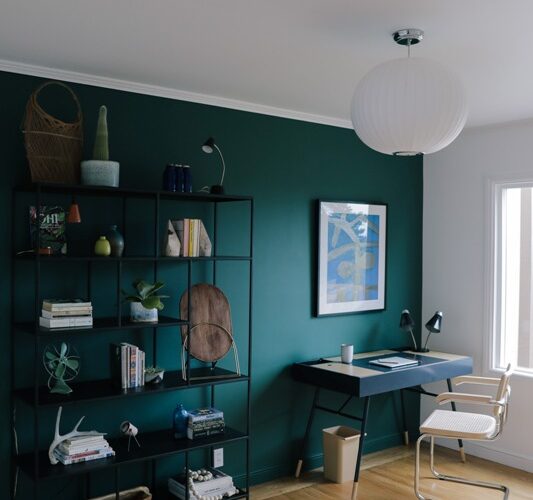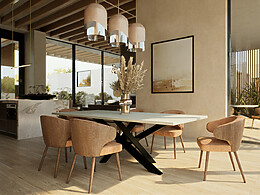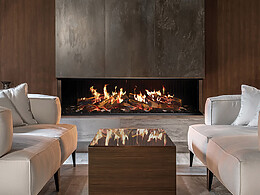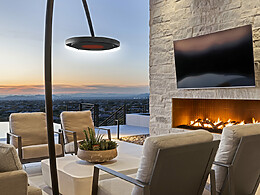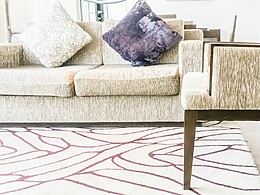
Click here to view bookcase
Now that your home office has to actually be used as an office–and not just a space to store Christmas decorations and that one box you still haven’t unpacked–Stephanie Kennedy, national retail market manager of Customer Care for Room & Board, walks us through creating the ultimate office space.
What should one consider when choosing a desk?
Before buying your desk, it helps to have an idea of the amount of workspace your equipment takes up. We often think the wider the desk the better, but it’s incredible how much more functional a deeper surface (30-in. vs 24-in.) can be when you do a lot of typing on a daily basis.
When choosing an office chair, what should one consider in terms of ensuring it is practical and not just good looking?
We’re big fans of chairs with an ergonomic design that can be adjusted to your body. Seat height and lumbar support are crucial for long days at a desk.

Click here to view chair
Do you have tips for how to orientate furniture within a home office?
More generally, it’s about making the most of the area you have to work with thinking about what’s most important to you for your home office/workspace so it’s as functional as it can be. As with any room, the arrangement should have a natural flow that feels comfortable and in this case, productive.
Capitalizing on a window and natural light is also something we recommend. Nice to place the desk to see outside if you do have a window.
People in general seem to be more comfortable without our backs to the door as well.
It’s also important to be sure you have enough space behind you to comfortably pull your chair out from whatever you are using as a desk. About 3ft is what we typically recommend.
Never work from bed! Though it may seem cozy at first, it’s important for your mental and emotional health to have a clear division between work time and leisure time. Instead, intentionally choose furniture you love for a designated work space.
What ideas do you have for a couple or partners who are sharing a home office?
If you can, try to set up separate work stations in different rooms of your home. This can be tough in small spaces and you may need to get creative (ex: one desk in the living room, one in the bedroom), but the physical boundary of walls between you as you work will psychologically help establish work life vs. personal life. If you are limited to working from the same room, do your best to respect your partner’s time and responsibilities and try not to distract each other while working.
If separate spaces within the home aren’t possible, a U-shape desk is a nice option. This can allow two people to work back to back to allow for more focus while still taking advantage of the shared resources.
How should people approach bookshelves?
Many of us tend to overload our bookshelves with unnecessary clutter. Organized shelves are a great opportunity to elevate the style of a room while enhancing their functionality. Take some time to sort through the books and items you rarely use to give away to a friend or donate.

Click here to view task lamp
What lights work best for an office?
A good rule of thumb for any room is to try and incorporate three light sources, i.e. a task lamp, a floor lamp and your overhead lighting. The brighter the space, the more energetic you will feel!
Office art: what are the guidelines for this?
Just like with bookshelves, it can be easy to go overboard with the amount of art you choose to hang on walls. It’s a good idea to limit the focal points in the room to one or two walls. This will ensure your office doesn’t feel too bogged down with clutter.
However, a good rule of thumb is whatever you love or makes you happy.
Are there certain components of a home office that people don’t usually consider but should?
For those of us struggling with the new reality of working from home, it can help to try to “replicate” your typical work set up. Set up your monitors, phone and task light in the same configuration as what you are familiar with in your normal office setting and place a waste basket in a similar area as you’re used to. This can make the transition a little more comfortable and help with your work flow.
Another little tip is a foot stool – makes a world of difference for comfort and ergonomics!






